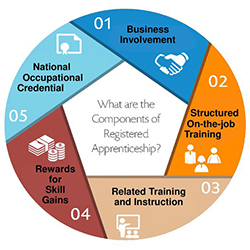Making Apprenticeships Work for You

On May 27th, FRA hosted a webinar titled: Making Apprenticeships Work for You.
Marie Price (Director of Training and Development, Idaho Forest Group); Brenda Myers (State Director/MS, DOL Apprenticeship Division); and Dale Lemmons (President, Signature Transport) talked about their experiences with the Registered Apprenticeship Program, the program’s benefits, and ways that companies can get involved at the state and federal levels.

If you were able to join in for the webinar, how was it? Let me know your thoughts – we are always looking for feedback, and if you have more intel to share with others – we welcome that too!
If you were unable to join the webinar live, please click HERE to watch the recorded webinar to learn from those who have experiences to share.
Highlights of the webinar:
What is Registered Apprenticeship?
- A career pathway where an individual can obtain workplace knowledge and skills by participating in:
- A paid work component, and
- An educational or instructional component.
- Registered Apprenticeship is a federal program managed by each state. The states either have their own apprenticeship council to approve and manage apprenticeship programs or work directly with the U.S. Department of Labor to do so.
What are the components of Registered Apprenticeship?
- Direct Business Involvement – Employers are the foundation of every Registered Apprenticeship program.
- On-the-job Training – Apprentices receive on-the-job training from an experienced mentor, typically for not less than one year.
- Related Instruction – Apprenticeships combine on-the-job learning with technical education at community colleges, technical schools, apprenticeship training schools, provided online or at the job site.
- Rewards for Skill Gains – Apprentices receive increases in wages as they gain higher-level skills.
- National Occupation Credential – Registered Apprenticeship programs result in a nationally recognized credential – a 100 percent guarantee to employers that apprentices are fully qualified for the job.
What are the benefits to an apprentice?
- Paid Job – earn a paycheck from day one, guaranteed to increase over time as you learn new skills.
- Career Advancement – Leverage your completed apprenticeship to further your career in a chosen field.
- Hands-on Training – Learn job skills in a wide range of industries such as health care, construction, information technology, and geospatial careers.
- Degree Potential – Get academic credit towards a college degree for the skills you learn during your apprenticeship.
- Credentials – Receive an industry-issued credential upon completion of an apprenticeship program.
- Connections – Meet people who can help you advance your career today and in the future.
What are the benefits to an employer who utilizes an apprenticeship?
- Skilled Workforce – Recruit and develop a highly skilled workforce that helps you grow your business. Investing in a skilled workforce pays dividends for your business and contributes to a stronger economy.
- Return on Investment – You will be getting an employee who can contribute immediately. Even if your apprentice has a lot to learn, they will be adding person-power to your operation at 50-60% of a regular employee.
- Positive Impact to Bottom Line – Improve productivity, profitability, and your bottom line.
- Reduce Turnover and Retain Workers – Minimize cost with reduced turnover and liability. Ninety-four percent of apprentices continue employment after completing an apprenticeship. Employees are loyal to employers who invest in their skills and professional development. Stronger work teams also evolve through the mentoring built into apprenticeships.
- Customizable Training – Create flexible training options that ensure workers develop the right skills. You are in the driver’s seat, designing a program that trains employees to industry standards and your way of doing business. As your business needs evolve, adjust the size and curriculum of your program.
- Diversity – Foster a diverse and inclusive culture.
What is STRAP (School to Registered Apprenticeship), and how does it work?
- STRAP connects high schools and organizations so that select students can begin learning a skill directly from a company.
Students aged 16-17 may work in certain hazardous occupations if the following criteria are met:
- The employer is a program sponsor for Registered Apprenticeship and enrolls the student in an approved apprenticeship program.
- A STRAP agreement is signed between the high school and employer.
- Students must be in good standing at their school.
- Students must be enrolled in a related Career Technical course.
- Students’ parents must sign the apprenticeship agreement.
- The student must be under the supervision of a journeyman at all times.
To get started:
- Review the Department of Labor’s website: apprenticeship.gov/employers.
- Contact your state’s apprenticeship office.
The webinar included many experiences shared by the presenters that are invaluable if you plan to move forward with Registered Apprenticeship. Check it out here: Making Apprenticeships Work for You.


